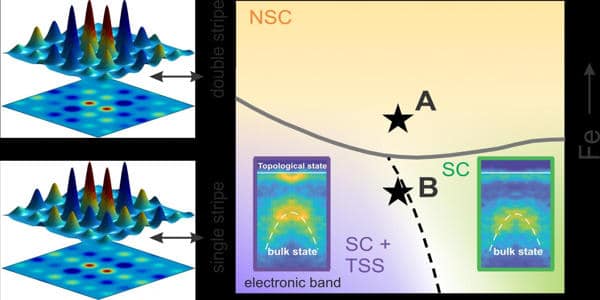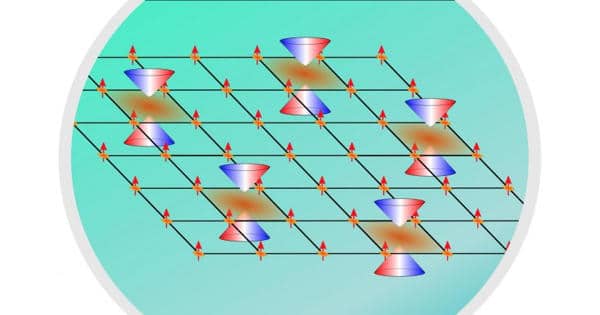The electronic states of a compound containing iron, tellurium, and selenium were studied to see how they change with local chemical concentrations. They discovered that when the local concentration of iron is sufficiently low, superconductivity (conducting electricity without resistance) appears, along with distinct magnetic correlations; when the concentration of tellurium is sufficiently high, a coexisting electronic state existing only at the surface (topological surface state) appears. Their findings, published in Nature Materials, point to the composition range required for topological superconductivity. Topological superconductivity could enable more robust quantum computing, which promises to deliver exponential increases in processing power.
“Quantum computing is still in its infancy, and one of the key challenges is reducing the error rate of computations,” said first author Yangmu Li, a postdoc in the Neutron Scattering Group of the Condensed Matter Physics and Materials Science (CMPMS) Division at the DOE’s Brookhaven National Laboratory. “Errors occur when qubits, or quantum information bits, interact with their surroundings.” Topological superconducting qubits, on the other hand, are intrinsically protected from noise, unlike trapped ions or solid-state qubits such as point defects in diamonds. Therefore, they could support computation less prone to errors. The question is, where can we find topological superconductivity?
Scientists mapped the electronic states in an exotic superconductor. The maps point to the composition range necessary for topological superconductivity, a state that could enable more robust quantum computing.
The scientists focused their search in this study on one compound that is known to host topological surface states and is part of the family of iron-based superconductors. Topological and superconducting states are not distributed uniformly across the surface of this compound. Understanding what causes these variations in electronic states, and how to control them, is critical for enabling practical applications such as topologically protected quantum computing.
Based on previous research, the team knew that changing the amount of iron in the material could cause it to transition from a superconducting to a nonsuperconducting state. For this study, CMPMS Division physicist Gendu Gu grew two types of large single crystals, one with slightly more iron than the other. The sample with the higher iron content is not superconducting, while the other sample is.
The team used spin-polarized neutron scattering to determine whether the arrangement of electrons in the bulk of the material differed between superconducting and nonsuperconducting samples. The Spallation Neutron Source (SNS) at the Department of Energy’s Oak Ridge National Laboratory houses a one-of-a-kind instrument for performing this technique.
“Neutron scattering can tell us the magnetic moments, or spins, of electrons and the atomic structure of a material,” explained corresponding author Igor Zaliznyak, a physicist in the CMPMS Division Neutron Scattering Group who led the Brookhaven team that helped design and install the instrument with Oak Ridge collaborators. “To isolate the magnetic properties of electrons, we polarize the neutrons with a mirror that only reflects one specific spin direction.”
Surprisingly, the scientists discovered vastly different patterns of electron magnetic moments in the two samples. As a result, a slight change in the amount of iron resulted in a change in the electronic state. “After seeing such a dramatic change, we decided to investigate the distribution of electronic states as a function of local chemical composition,” Zaliznyak explained.

Li used energy-dispersive x-ray spectroscopy to determine the chemical composition of representative smaller pieces of both sample types at Brookhaven’s Center for Functional Nanomaterials (CFN), with assistance from CFN staff members Fernando Camino and Gwen Wright. A sample is bombarded with electrons in this technique, and the emitted x-rays characteristic of different elements are detected. They also used microscale electrical probes to measure the local electrical resistance, which indicates how coherently electrons can transport charge. Li created a small square grid for each crystal (100 by 100 microns). In total, the team mapped the local composition and resistance at more than 2,000 different locations.
“Through the CFN experiments, we characterized the chemistry and overall conduction properties of the electrons,” Zaliznyak explained. “However, we must also characterize the microscopic electronic properties of the material, or how electrons propagate in it, whether in the bulk or on the surface. Induced superconductivity in electrons propagating on the surface can host topological objects known as Majorana modes, which are one of the best ways to perform quantum computations in theory. Photoemission spectroscopy can provide information on bulk and surface electronic properties.”
Zaliznyak and Li contacted Peter Johnson, the leader of the CMPMS Division Electron Spectroscopy Group, and Nader Zaki, a scientific associate in Johnson’s group, for the photoemission spectroscopy experiments. They quantified the strengths of the electronic states propagating on the surface, in the bulk, and forming the superconducting state by measuring the energy and momentum of electrons ejected from the samples in response to light (using the same spatial grid). They fit the photoemission spectra quantitatively to a model that characterizes the strengths of these states.
Then, the team mapped the electronic state strengths as a function of local composition, essentially building a phase diagram.
“This phase diagram includes superconducting and topological phase transitions and points to where we might be able to find a useful chemical composition for quantum computation materials,” Li explained. “There are no coherent electronic states for certain compositions to develop topological superconductivity. Previous research suggested that the lack of topological superconductivity features was due to instrument failure or measurement error. We show that it is due to the electronic states themselves in this case.”
“You can expect fluctuations when the material is close to the transition between the topological and nontopological states,” Zaliznyak added. “Electronic states must be well-developed and coherent for the topology to emerge. As a result, from a technological standpoint, we must synthesize materials away from the transition line.”
The scientists will then expand the phase diagram to investigate the compositional range in the topological direction, concentrating on samples with less selenium and more tellurium. They are also considering using neutron scattering to investigate an unexpected energy gap (an energy range in which no electrons are permitted) that has opened in the topological surface state of the same compound. Johnson’s group discovered this gap recently and hypothesized that it was caused by surface magnetism.















